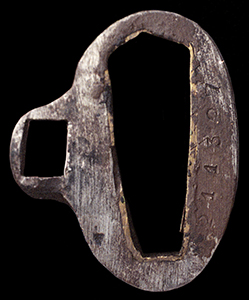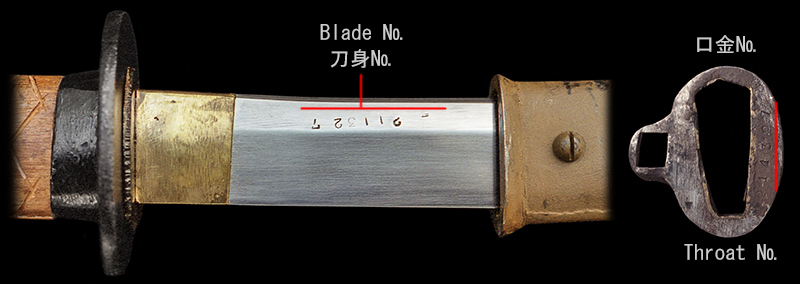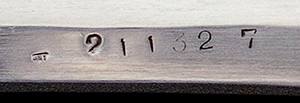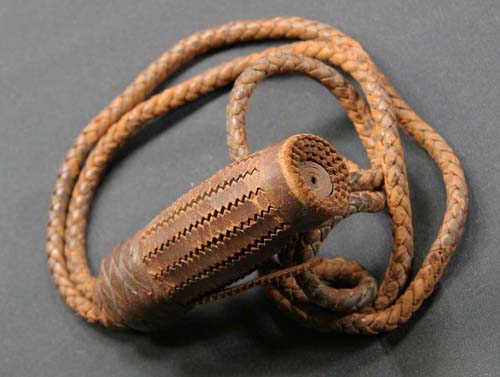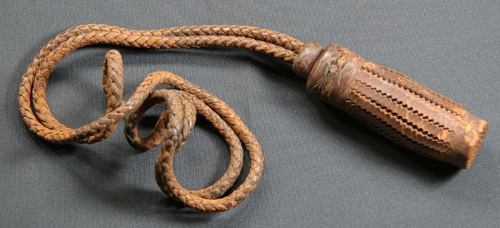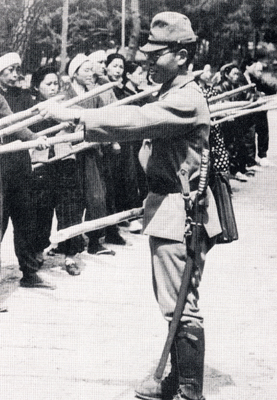����R���@�O���ו�(2)0
�O���ו�(2)
Mounting details(2)
�� �ˁ@Chape (Ishizuki)
��
�� �� �� �� ��
����(���q)�Ɩ��É����R�������ł͓��g����A��I�[�̋Ȑ��A�ƒ��S�^�Γ˂̌`��Ɍ����ȍ�������
Discernment of an arsenal
The stamp of a blade, the curve of a scabbard backend, a shoe chape
differ by
Tōkyō (Kokura) and the Nagoya army arsenal.
�@�@�@�@�@�@�@�@�@�@�@�@�@�������@������T
�@�@�@�@�@�@�@�@�@�@�@�@Serial ���@arsenal inspection mark "To" or "T"
�@�@�@�@�@�@�@�@�@�@�@�@�@������ͼره��̌� �@�}�C�i�X�l�W(�����~��)�͗��� �@�@�J�[�u���ɂ₩
�@�@�@�@�@�@�@�@�@ �V�n�t�����������@�@�����͊�
�@�@�@�@�@�@�@�@�@�@�� for reverse�@arsenal inspection mark "Mei" or
"Seki"
�@�@�@�@�@�@�@�@�@�@�@�@�@������ͼره��̑O�@�}�C�i�X�l�W ( �����~�� )�@�ꍞ�ݗ��[���Ȑ���`��
�@�唼�͓��g�E�O�����ɓ��ꑢ�����ɂȂ��Ă��邪�A�K�����̑g�ݍ��킹�Ƃ͌���Ȃ��B
�@�����^�f�ڗ�:9090T�͖��É������̊O���ɓ���(���q)�����g�B�ŏI�����ӔC�������������g������ƈ�v���Ă��Ȃ��̂Ő��Y
�̓s���ő������Ԃœ��g���݂��ɗZ�ʂ��������\���������B���݁A�^���͕s���B
�@�f�ڗ�ɂ���O������Ƃ������Ƃ́A���Ȃ葶�݂����Ǝv����B�O����̓����͏����`�������ς���Ă��Ȃ��B
1
�����f�ʁ@
Throat section
�@�@�@�@�@�@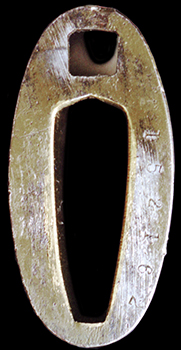
�@�@�@�@�@�@�@�@�ŏ����`����
�@�@�@�@�@�@��̒f�ʌ`��͒��ȉ~
�@�@�@A beginning term - the middle.
The cross-sectional shape of a scabbard
is a long ellipse.
|
�@�@�@�@�@�@�@�@�����T�C�h���܁`�Ŗ���
�@�@�@�@�@�@�@��̒f�ʌ`��͊p�������ȉ~
�@A middle side spring clip - the maximum last stage.
The cross-sectional shape of a scabbard is the
square ellipse.
|
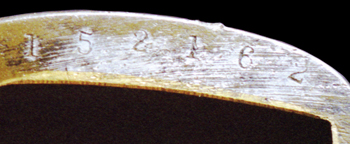
|
�@�@
|
�@�@�@�@�@�@�V���A�����@152162
|
�@�@�@�@�@�@�@�@�V���A�����@211327 |
���g���ƌ������̈�v
�@�S�����E�ՁE�؉H:
�S�����ɂ͑������E������A���ԉ�Ѝ���͖����B����: �V���A��
���݂̂ŁA��������Ȃ�
�@���É����R�������֕��H�ꐻ���g(���g�� ��211327)�B���g������@�u�ցv�͉����m�F�����̂݁B������͈�ʂɔ���
A
last stage type mounting and a blade.
�@Iron ferrule, guard and washers:�@An arsenal inspection mark, and a private corporation stamp are not in
iron ferrule.
�@Throat:�@With
no inspection stamp.
�@Nagoya army arsenal Seki part factory blade (blade No.Seki
211327). Blade inspection mark In "Seki", the bottom is
only checked. Generally the inspection mark is thin.
�@���S�K�i���g�������g���ɔ����ȍ�������A����q��ň�U�薈�ɒ������Ă���B���ׁ̈A���g���Ɠ���̇���������ɍ���B
�@�ŏ����^�`�����^�ł͓��g���Ə�̌������͕K����v����B
�@������v���Ȃ������L��A���A�ʂ̓��g���A���͏����ō��킹�����ł���B
�@���ɂ͇���͖������A���̓���q�Ōs�̍��l��
�������Ă���B�Ŗ����^�̌����ɂ͇�����͖����B
�@Coincidence of blade �� and stamp �� of a scabbard: Stamp No.of a
blade, a throat, and a chape must be the same.
2
�@�R������(��)����̂́A�u�m���E�y�m���v(�y��(��������)�A�㋉���m���́u�����v�ł���B
�@�����E�������m���́u�R���E�ޒ��v�y�сu���v�͑ѓ��ł��Ȃ������B����R�����A�ʏ́u�������v�Ɖ]���鏊�Ȃł���B
�@�R���u�R���ȁv�Ɓu������=�����ȏ�ŕҐ��v�͌R�����K�������i�ł���A���̕��Ȃł͉��m���E���̑S�����R����Ηp�����B
�@�����������m���E�����u�ѓ��{�����v�Ƃ����B
�@�R���ȁE�����ȈȊO�ł��A�����Ȗ{�������̌R���E�ޒ��͑ѓ��������ꂽ�B
�@�����Ȃ͕����e�����邪�A�X�ɕ���������Ȃ��u�C���v�E�u�H���v�E�u�n�d���v�́A����18�E19�N�̗p(�b�E���E��)�̗m��
�Z�R��(Hanger �ʏ̃S�{�E���B�C�����̍��ڎQ��)����ттĂ����B����͌�ɎO�\�N���e���ɑւ��B
�@�R���A��n�̏Ɉ˂�Ջ@���ς������悤�ŁA�x�ߎ��ς̏����ɂ͑O���̌R���E�ޒ������ɑѓ����Ă���B
�@�R�̕������R�����(��)���A ���M(�Ă�����)�E��
�����̌R�����u�R�����v���g�����B
Class
which can have a noncommissioned officer sword
�@The army staff sergeant who trains a bamboo spear to the Ladies'
Society for National Defense. The regular position which carries a
Guntō can be checked.
�@The a private which can carry a Guntō.
�@"An Officer, �varrant Officer", and "senior noncommissioned officers' Sergeant Major" can carry a Guntō only.
�@"A Staff Sergeant and a Sergeant" of the middle class and a junior noncommissioned officer and a "a Private" cannot carry a Guntō. Therefore, a Type 95 Guntō is called common name "Sergeant Major sword". However, Guntōes are necessary general tools "composing the department of a military policeman above a corporal" and "the department of a Cavalry",
and a noncommissioned officer and all the members of a a private carried the Guntō in this arming.
�@Such a noncommissioned officer and a a private are called "private permitted carrying a Guntō = Taitō Honbun Hei".
�@The staff sergeant and the sergeant belonging to infantry-arm headquarters were permitted carrying a Guntō also
except the department of a Cavalry and a military policeman.
�@Although the foot soldier equipped the gun, the
"artilleryman", the "combat engineer", and the "transport soldier" who do not have arms separately carried the westan type short Guntō of adoption in 1885 - 1886.
�@This is behind replaced with a Type 30 bayonet. However, it depends on the situation of a battlefield, and as adaptable, in early stages of the China incident, a frontal staff sergeant and a sergeant have already carried the Guntō. The civil servant of a military also carried the Gunto and army civilian employees, such as a mail, and a report, also carried the "army civilian employee sword ".
2005�N2�����
�y�[�W�̃g�b�v����
 �@�@
�@�@





